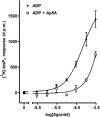ADP stimulation of inositol phosphates in hepatocytes: role of conversion to ATP and stimulation of P2Y2 receptors
- PMID: 12522099
- PMCID: PMC1573642
- DOI: 10.1038/sj.bjp.0705016
ADP stimulation of inositol phosphates in hepatocytes: role of conversion to ATP and stimulation of P2Y2 receptors
Abstract
1 Accumulation of inositol (poly)phosphates (InsP(x)) has been studied in rat hepatocytes labelled with [(3)H]inositol. Stimulation with ADP resulted in a significant increase in total [(3)H]InsP(x), whereas 2-MeSADP had only a small effect and ADPbetaS was ineffective. UTP and ITP also stimulated substantial increases in [(3)H]InsP(x). 2 The dose-response curve to ADP was largely unaltered by the presence of the P2Y(1) antagonist, adenosine-3'-phosphate-5'-phosphate (A3P5P). Similarly, inclusion of MRS 2179, a more selective P2Y(1) antagonist, had no effect on the dose-response curve to ADP. 3 The inclusion of hexokinase in the assay reduced, but did not abolish, the response to ADP. 4 HPLC analysis revealed that ADP in the medium was rapidly converted to AMP and ATP. The inclusion of hexokinase removed ATP, but exacerbated the decline in ADP concentration, leading to increased levels of AMP. 2-MeSADP was stable in the medium and ATP was largely unaffected. 5 The addition of the adenylate kinase inhibitor, diadenosine pentaphosphate (Ap(5)A) significantly reduced the ADP response. HPLC analysis conducted in parallel demonstrated that this treatment inhibited conversion of ADP to ATP and AMP. 6 Inclusion of the P1 antagonist CGS 15943 had no effect on the dose-response curve to ADP. 7 These observations indicate that hepatocytes respond to ADP with an increase in inositol (poly)phosphates following conversion to ATP. P2Y(1) activation in hepatocytes does not appear to be coupled to inositol 1,4,5-trisphosphate (Ins(1,4,5)P(3)) production.
Figures





Similar articles
-
Regulation of brain capillary endothelial cells by P2Y receptors coupled to Ca2+, phospholipase C and mitogen-activated protein kinase.Br J Pharmacol. 1997 Nov;122(5):935-41. doi: 10.1038/sj.bjp.0701453. Br J Pharmacol. 1997. PMID: 9384512 Free PMC article.
-
P2Y(2) receptor-stimulated phosphoinositide hydrolysis and Ca(2+) mobilization in tracheal epithelial cells.Am J Physiol Lung Cell Mol Physiol. 2000 Aug;279(2):L235-41. doi: 10.1152/ajplung.2000.279.2.L235. Am J Physiol Lung Cell Mol Physiol. 2000. PMID: 10926546
-
ATP and UTP responses of cultured rat aortic smooth muscle cells revisited: dominance of P2Y2 receptors.Br J Pharmacol. 2003 Dec;140(7):1169-76. doi: 10.1038/sj.bjp.0705526. Epub 2003 Nov 3. Br J Pharmacol. 2003. PMID: 14597595 Free PMC article.
-
Regulation of rat hepatocyte function by P2Y receptors: focus on control of glycogen phosphorylase and cyclic AMP by 2-methylthioadenosine 5'-diphosphate.J Pharmacol Exp Ther. 2004 Oct;311(1):334-41. doi: 10.1124/jpet.104.067744. Epub 2004 May 19. J Pharmacol Exp Ther. 2004. PMID: 15152027
-
Anion Receptors for the Discrimination of ATP and ADP in Biological Media.Chempluschem. 2021 Jan;86(1):59-70. doi: 10.1002/cplu.202000567. Epub 2020 Oct 15. Chempluschem. 2021. PMID: 33058508 Review.
Cited by
-
Receptor-specific Ca2+ oscillation patterns mediated by differential regulation of P2Y purinergic receptors in rat hepatocytes.iScience. 2021 Sep 16;24(10):103139. doi: 10.1016/j.isci.2021.103139. eCollection 2021 Oct 22. iScience. 2021. PMID: 34646983 Free PMC article.
-
The role of purinergic signaling in the liver and in transplantation: effects of extracellular nucleotides on hepatic graft vascular injury, rejection and metabolism.Front Biosci. 2008 Jan 1;13:2588-603. doi: 10.2741/2868. Front Biosci. 2008. PMID: 17981736 Free PMC article. Review.
-
Extracellular nucleotides inhibit insulin receptor signaling, stimulate autophagy and control lipoprotein secretion.PLoS One. 2012;7(5):e36916. doi: 10.1371/journal.pone.0036916. Epub 2012 May 10. PLoS One. 2012. PMID: 22590634 Free PMC article.
References
-
- BOYER J.L., ROMERO-AVILA T., SCHACHTER J.B., HARDEN T.K. Identification of competitive antagonists of the P2Y1 receptor. Mol. Pharmacol. 1996;50:1323–1329. - PubMed
Publication types
MeSH terms
Substances
LinkOut - more resources
Full Text Sources

